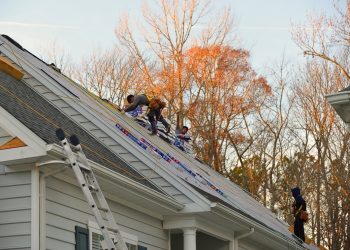 Last month at the REALTORS® Legislative Meetings & Trade Expo, NAR made the .REALTOR domain available to local and state REALTOR® associations as well as brokerages in the U.S. and Canada. This move followed the domain’s launch to NAR members this past October. Before the year is out, NAR will up the ante even further by rolling out the .realestate domain to REALTOR® and broker members.
Last month at the REALTORS® Legislative Meetings & Trade Expo, NAR made the .REALTOR domain available to local and state REALTOR® associations as well as brokerages in the U.S. and Canada. This move followed the domain’s launch to NAR members this past October. Before the year is out, NAR will up the ante even further by rolling out the .realestate domain to REALTOR® and broker members.
The introduction of these top-level domains (TLD) is exciting news for real estate professionals, yet critics point to an allegedly low adoption rate, and hint that this is perhaps just a way for NAR to add to its bottom line. However, there is a much bigger picture to consider, one that clearly depicts why securing these domains matters for the future of your business and the real estate industry as a whole. I recently had the opportunity to sit down with NAR execs Bob Goldberg and Ken Burlington, and Tom and Matt Embrescia with Second Generation, a firm who specializes in securing top-level domains (TLDs) for a wide variety of industry-leading organizations. The group provided an in-depth look at how and why the initiative came to be, and why it is a critical move for NAR and its members.
According to Goldberg, NAR SVP of Marketing, Business Development and Member Benefits, “This is not just NAR dabbling in something. TLDs are key to how the Internet is being used—we feel it’s an obligation to help our brokers and REALTORS®. We feel we have a responsibility to do something to make sure the industry is protected. We did it as an offensive move as much as a defensive move. Think about if an interloper got .REALTOR or .realestate? We need to make sure that when people think real estate, there’s someone trusted behind it. Consumers know our brand and we needed to leverage that with a top-level domain.”
So, let’s talk about TLDs. NAR was one of the first associations approved for a TLD, a process that took eight years of working with the Internet Corporation for Assigned Names and Numbers (ICANN), the organization that coordinates domains and Internet Protocol addresses around the world. Clearly, this was not a money-making scheme for NAR (who is offering one free domain to early-adopting members and various discounts to brokers), but rather, an intensive process that took commitment, financial investment and stamina. According to ICANN, the .REALTOR domain is currently the sixth fastest-growing domain in existence.
The reason TLDs are critical, and the reason why NAR has made the initiative a priority, is because they represent the very near future of the Internet. Right now, for example, I could launch a website with the URL MariaPattersonRealty.com, but there is nothing that governs what my site is all about—I could be selling knock-off Chanel purses or promoting a bogus weight-loss pill. As it stands now, the Internet can be easily misused to the REALTOR®’s—and the real estate industry’s—disadvantage. Not only does this hurt the credibility the industry has strived so hard to achieve, it leaves the consumer in the lurch when they need to find a real estate professional to work with.
“A lot of governments around the world are concerned about what’s happening on the Internet,” explains Tom Embrescia, chairman of Second Generation subsidiary Real Estate Domains, LLC, an investment firm and registry operator for the top-level domain .jobs, who worked with Goldberg and his team to secure the .REALTOR and .realestate TLDs. “Last year, nikeshoes.com sold $90 million worth of Nike shoes. Sounds great. The only downside is, it was a Chinese knock-off company—and the consumer doesn’t know that. TLDs are about eliminating a lot of phishing and scamming, so ICANN is looking for exactly the kind of partnership they created with NAR to build trusted valued sources on the Internet.”
Enter the .REALTOR domain. To get a .REALTOR domain, a member is pinged against the NRDS database, or the CREA database in Canada, to validate that you are indeed a member of NAR who must abide by the code of the largest association in the United States. If you’re a consumer looking for a credible real estate resource, you can shave off a lot of time and hassle by going directly to a .REALTOR domain. “A .REALTOR Web address is an opportunity to tell consumers that if someone has a .REALTOR domain, they are a member in good standing who abides by the Code of Ethics of the NAR or CREA,” explains Goldberg.
“Consumers over time will know that if they’re on a .REALTOR domain, they’re working with a REALTOR®, a trusted real estate resource.”
According to Tom Embrescia, with over 250 million URLs in existence, moving to 500 million in three to five years, “For a REALTOR®, what’s happening on the Internet today is a tough road to navigate—it keeps transitioning, keeps growing, keeps changing. NAR has taken the position that it’s their job to figure out the best method, then make it easy and affordable for REALTORS® to do it. The REALTOR® Community needs to separate themselves, or they will become generic online.”
But if that’s the case, say the critics, why hasn’t every REALTOR® in the country snatched a .REALTOR domain by now? According to ICANN, the fact of the matter is, the .REALTOR domain is the sixth fastest-growing TLD currently in existence. As with most technology-related concepts for the real estate industry, adoption takes time. Ideas and programs must be fully vetted before gaining mass appeal. Don’t forget that the Internet was positioned as “the lion coming over the hill” not all that long ago. Now look. It stands to reason that .REALTOR adoption will follow suit.
“We are truly very pleased with the adoption rate so far,” emphasizes Goldberg. “All of us at NAR and our partners are happy with the number of domains claimed.”
Meanwhile, the early adopters of the .REALTOR domain are enjoying a big competitive advantage. While members get one domain for free, they can affordably buy as many as they’d like, boxing out their competition in the process. According to Goldberg, many members have done just that, citing one REALTOR® who bought 50 TLDs.
“People have one site and they think it’s the solution,” says Tom Embrescia. “But the reality is, you want multiple ways to be found based on how people search. The more URL opportunities you have at an inexpensive price point, the better you can market yourself. If the search terms people use are in your domain name, you’re going to be found on the search engines.”
What’s more, these REALTORS® aren’t just “parking” their .REALTOR domains, they’re actually using them, whereas the converse exists in the .com world. According to a November ’14 article on thedomains.com, the .REALTOR extension had by far the lowest rate of parked domains at the time—just over 1 percent, according to ntldstats.com.
“There are a lot of people today called ‘domainers’ who look to buy domain names and shelve them,” explains Tom Embrescia. “Of all the .com names that exist, about half of them don’t get resolved, meaning you own a .com name but you never turn it into a page. On the other hand, .REALTOR is the most-used TLD of all the new TLDs that have launched up until now. That’s the telling part. There’s a functionality to it. NAR is the PhD, MBA and CPA of real estate. And like them, REALTORS® need to separate themselves from all the others working in real estate.”
An easy way to understand the importance of the .REALTOR domain is to look at what’s happening in terms of specialization in other large industries. According to Tom Embrescia, ICANN is moving full speed ahead. “.com will always exist,” he explains, “but it will be all things to all people—like NBC, CBS, ABC. But when you create a vertical—like .realtor and .realestate—it’s now ESPN or the Food Network. ESPN is a bigger value for the Disney Corp. than ABC is, and Disney owns them both. For REALTORS® who don’t focus on this and separate themselves out, they’re going to be eroded on the Internet.”
And NAR isn’t alone—they’re joined by the likes of Google and Amazon, which are also in the process of securing TLDs. “NAR is well ahead of the curve,” adds Embresica.












